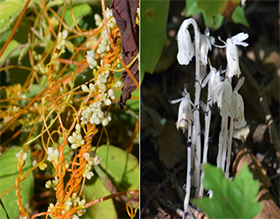 Flowering plants (angiosperms; as opposed to other land plants like evergreens, ferns, and mosses) are characterized by flowers that produce seeds encapsulated within a fruit. Those flowers provide the beautiful displays of color that adorn our parkland woods and meadows for much of the year. But, of course, the color that dominates those habitats is green.
Flowering plants (angiosperms; as opposed to other land plants like evergreens, ferns, and mosses) are characterized by flowers that produce seeds encapsulated within a fruit. Those flowers provide the beautiful displays of color that adorn our parkland woods and meadows for much of the year. But, of course, the color that dominates those habitats is green.
The green color of plants derives from chlorophyll, a pigment molecule that captures energy from sunlight. Chlorophyll absorbs blue and red light most strongly, and so we see the reflected, unabsorbed green light. That absorbed solar energy promotes a series of chemical reactions—photosynthesis—that ultimately result in the formation of plant sugars. Flowering plants evolved about 125 million years ago, but chlorophyll and photosynthesis arose much earlier. In fact, the cellular structures—chloroplasts—that contain chlorophyll in flowering plants are understood to have evolved about a billion years ago, when photosynthetic bacteria (cyanobacteria) were engulfed and then retained inside the cells of what became green algae. Those green algae eventually gave rise to land plants. That early evolutionary step—the incorporation of free-living bacteria into algal cells—is an example of biological symbiosis, the sustained interaction of two species of organisms in nature. Symbiotic relationships take many forms, ranging from mutualistic (in which both partners benefit) to parasitic (in which one partner suffers), and they underlie the great web of interactions that form ecosystems.
Photosynthesis allows an organism to create its own food, which is a great advantage. So, it might be surprising to consider that some flowering plants have given up that benefit. But indeed, something like 1% of angiosperms produce little or no chlorophyll; they are not green, and they are incapable of photosynthesis. As such, those plants need another method to obtain nutrients and energy. Two local examples illustrate how that is accomplished.
Dodder (genus Cuscuta) is represented locally by two similar-looking species, field dodder and common dodder. Dodders are related to morning glories, the green stems of which form tangles of vines and support showy colorful flowers. Dodder is “viney” too, but it is immediately recognizable in our meadows from its stringy orange stems climbing over and around a variety of other plants. That appearance is responsible for dodder’s many alternative names, including devil’s hair, strangleweed, hellbine, and others. Dodder is an annual, growing anew each year from seeds. As the young stems elongate, they sense chemicals emitted by favorable host plants and grow in that direction. Once contact is established, the dodder stem produces small protruding structures called haustoria, which penetrate into the host. Those haustoria then absorb nutrients that are circulating in the phloem fluid of the host (phloem distributes products of photosynthesis from the leaves to the rest of the plant). In other words, dodder is directly parasitic, not so different from a vampire, or a vampire bat, sucking blood. Dodder can substantially reduce vitality of its host, to the point that it can become a significant crop pest when that host has agricultural value. Eventually, dodder’s original roots disintegrate and the dodder becomes entirely dependent on the host for nutrition. In later summer, the stem supports a large number of small white flowers, and the subsequent seeds are shed to start the next generation.
Ghost plant (Monotropa uniflora, formerly called Indian pipe) take a less direct approach. Many of ghost plant’s relatives, like azaleas and rhododendrons, have vibrant flowers, but ghost plants themselves have a single wax-white stem that curves downward at the top to support a single wax-white bell of a flower. Given their lack of photosynthesis, ghost plants do not need to be in sunlight, and they typically grow in the shade of woodland trees. Those trees are photosynthetic—they form the green forest canopy—but they also exchange nutrients with an underground network of fungi that form an intimate association with the plant’s roots. Fungi with this role are known as mycorrhizae, and they provide the tree with essential elements like nitrogen and phosphorus; in return, the tree passes some of its sugars on to the fungi. That win/win exchange is an example of a mutualistic symbiosis. Ghost plants intrude on that system. Their fine root hairs intertwine with the network of fungal strands (mycelia) and absorb some of the nutrients that originally derived from the tree. In other words, the ghost plants are indirectly parasitic on the tree, and more directly parasitic on the fungus. It’s a mild parasitism, though, as there may be little actual detriment to the fungus or the tree. It turns out that ghost plants are able to establish this relationship with a particular group of mycorrhizal fungi—the Russulas—which in turn associate with particular types of trees. Ghost plants are commonly found in the vicinity of beech trees.
So, plants grow, flower, and fruit based on an ancient symbiosis that transitioned free-living photosynthetic bacteria into plant cell organelles. A plant that evolves to lose that association must develop an alternative symbiosis—parasitism of one sort or another– to compensate. All of these circumstances illustrate a guiding principle of ecological systems. That is, their function depends on the interactions between species. It’s all about connections.
Article and photo contributed by Dr. David L. Goldstein, Emeritus Professor, Department of Biological Sciences, Wright State University.
